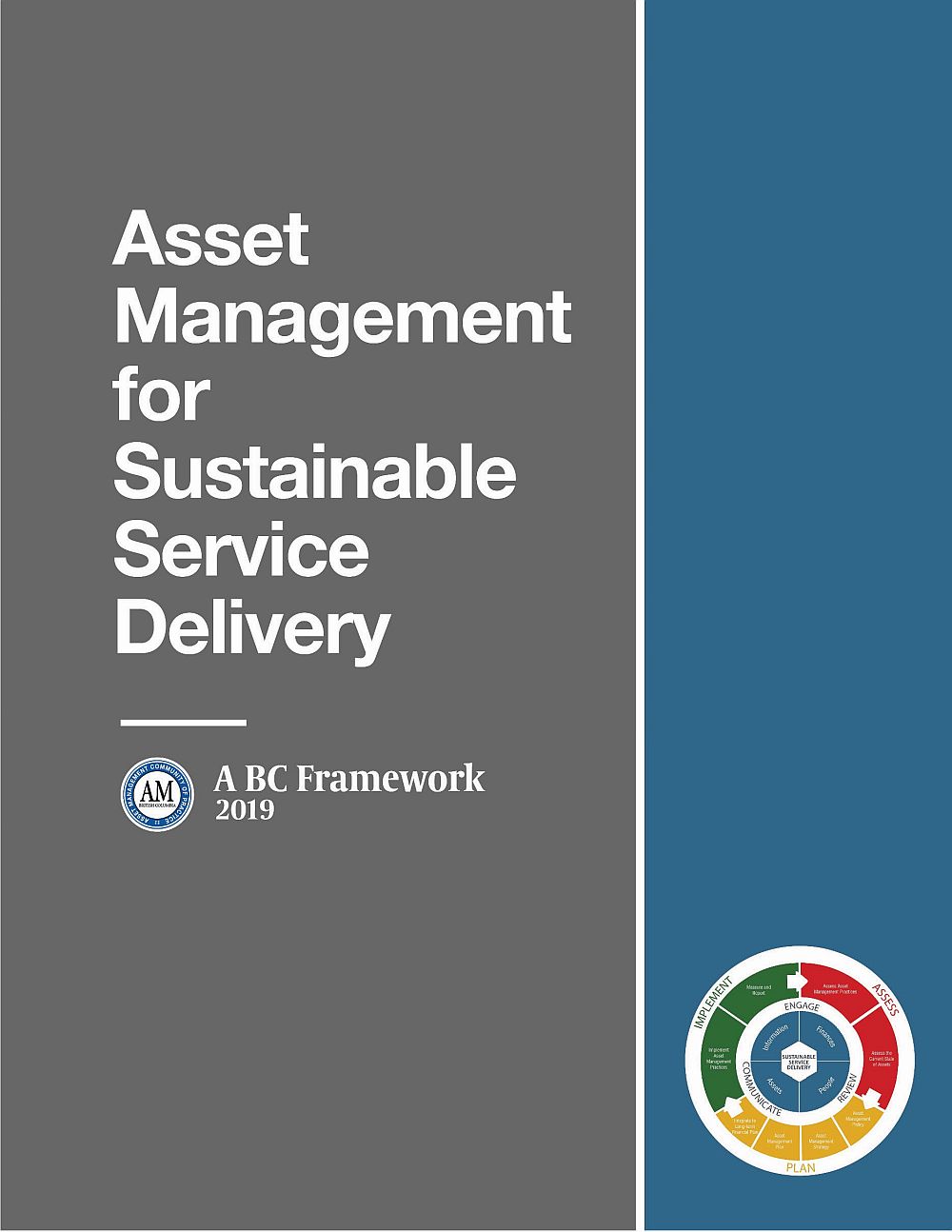ASSET MANAGEMENT FOR SUSTAINABLE SERVICE DELIVERY: “The title of the BC Framework is deliberate and important. The ‘function’ and responsibility of Municipal Councils and Regional Boards of Directors is Sustainable Service Delivery. The process to support decision making is Asset Management,” stated Glen Brown, Chair of the Asset Management BC Partnership Committee
Note to Reader:
The phrase “asset management for sustainable service delivery” is now an accepted part of the local government vocabulary in British Columbia. The phrase was formalized with release of Asset Management for Sustainable Service Delivery: A BC Framework in December 2014, and rollout in 2015. The emphasis on service is a game-changer for local government infrastructure asset management.
Tranformational in its scope and vision for a desired outcome, this guidance document was the culmination of a multi-year process. It represents a personal and sustained commitment by Glen Brown, Chair of the Asset Management BC Partnership Committee, to “make it happen”. Asset Management BC is a ‘community of practice’ initiative with provincial support and participation.
What was the genesis of the phrase “sustainable service delivery”? A decade ago, what was the initial process for mainstreaming it? Both questions are addressed in the article below. In this retrospective, Kim Stephens tell the story through a focus on the actions of Glen Brown as a key influencer in the world of government.
When reading this article, keep the thought in mind that an actionable vision is driven by leadership that mobilizes people and partnerships, a commitment to ongoing learning and innovation, and a budget to back it up.

Glen Brown has provided leadership at a provincial scale to transform the phrase ‘sustainable service delivery’ into an actionable vision for local government
In 2010, the success of the Nanaimo Region Water Pricing Workshop had ripple effects. This included inspiring the four Comox Valley local governments to change direction and build the 2011 Comox Valley Learning Lunch Seminar Series around the ‘sustainable service delivery’ theme.
The annual Comox Valley series program, held from 2008 through 2015, provided peer-based education. Everyone was learning together. Originally planned for the fall of 2010, the third annual Comox Valley Series was delayed until the spring of 2011.
As an outcome of what they learned at the RDN workshop, the Comox Valley regional team shifted the spotlight from a ‘regional response to climate change’ to the financial challenges associated with replacement of aging municipal infrastructure. Climate change became a sub-theme.
Sustainable Service Delivery: Coining of the Term in June 2010
“I remember the moment so well when Glen Brown first used the term ‘sustainable service delivery’ to capture what was in his mind. It was June 2010, and I was at the offices of the Regional District of Nanaimo (RDN). John Finnie and I were on a phone call with Glen. The purpose was to develop Glen’s part in the agenda for the Nanaimo Region Water Pricing Workshop in September 2010,” recalled Kim Stephens,m Executive Director, Partnership for Water Sustainability in British Columbia.
“At the time, Glen was an Executive Director in the provincial government; and John Finnie was General Manager, Regional and Community Utilities with the RDN.
“Our conversation took place the week after Glen had given a presentation at the Leadership Forum organized by the Local Government Leadership Academy. His title was a long one: Financial Accountability, Infrastructure Sustainability, Service Delivery: Connecting the Dots with an Asset Management Approach. Nowhere in that presentation did Glen use the specific term ‘sustainable service delivery’.”

An Easy-to-Remember Phrase
“During our brainstorming, Glen made repeated reference to the presentation; and expressed his desire to adapt it for the purposes of our upcoming event. As we talked, I kept pressing Glen to elaborate on what was in his mind so that John Finnie and I could help him crystallize a sound-bite for use as a compelling title.
“There was an Ah-ha Moment and the penny dropped. Glen, John and I had a collective epiphany when we realized that Glen’s headline should be What Does ‘Sustainable Service Delivery’ Mean to You? That became the title for his workshop presentation.
“In a nutshell, what happened during that conversation was that Glen Brown synthesized three ideas – financial accountability, infrastructure sustainability, service delivery – into a single easy to remember phrase: Sustainable Service Delivery. The rest is history, as they say.”
It is All about the Service
“A decade later, I asked Glen about his recollections of why and how Sustainable Service Delivery clicked in his mind. He answered as follows:
“My inspiration came from Guy Felio, who is one of the original gurus of asset management nationally. In his own words, and in a slide that I have seen him use in presentations since the mid-2000s, Guy Felio said, ‘It’s all about the service’.”
“Basically, well-maintained infrastructure/assets are worthless IF they do not provide a service. That is what resonated with me. Also, for any asset management approach to be successful, it must not focus on the infrastructure/asset by itself.”
“That way-of-thinking applies to nature and the environment as well – as long as we fully understand and appreciate the value of natural services – particularly when we leverage natural services to provide traditional community services, as well as those that are provided to support a healthy environment – that is, clean air, aquatic habitat, etc.,” concluded Glen Brown.
More to the Process than a Plan
The core document for asset management for BC local governments is Asset Management for Sustainable Service Delivery: A BC Framework. Glen Brown explains that:
“The title of the Framework is deliberate and important. The ‘function’ and responsibility of Municipal Councils and Regional Boards of Directors is Sustainable Service Delivery. The process to support decision making is Asset Management.
“The Framework provides the basis for the entire asset management process for our local governments to follow. Funding agencies, as part of funding applications, request communities to identify where they are within the asset management process using the framework..
“While much attention and discussion focus on the Asset Management plan or plans, there is much more to the process than just the plan. In fact, for Council, the implementation strategy and long-term financial plan are more important documents than the asset management plan itself.
“In 2019, we updated the ‘Framework’ and added new supporting content in the form of four Primers.”
Keeping in mind that it’s about “the service”, what service does this road to nowhere provide?

Image Credit: Guy Felio
A Local Government Program for Peer-Based Education
“Part of the rollout to stimulate a national dialogue on sustainable water management, the Nanaimo Region Water Pricing Workshop in September 2010 was a unique blend of research and practice. The workshop connected dots: ‘conservation-oriented water pricing’ is a tool to achieve a larger end, which is ‘sustainable service delivery’.
“Unfortunately, Glen Brown took ill the night before the workshop. This meant that the formal unveiling of Sustainable Service Delivery in an outreach and professional development setting was delayed seven months until April 2011 when Glen was part of the faculty for the Comox Valley Learning Lunch Seminar Series.”
Comox Valley local governments embraced the vision for
‘A Regional Response to Infrastructure Liability’
“At that time, and thanks to the early work of the then newly formed Asset Management BC, local governments were starting to wrap their minds around the ‘20/80 Rule’ – that is, the initial capital cost of municipal infrastructure is about 20% of the ultimate total cost, and the other 80% is an unfunded liability.
“The 20/80 Rule provided context for the 2011 Comox Valley Series. Thus, the focus of the four participating local governments was on what would be involved in facilitating the shift to a life-cycle approach to financing of infrastructure. Under Glen Brown’s guidance, the team embraced this explanation:
- Tackling the unfunded infrastructure liability involves a life-cycle way of thinking about infrastructure needs and how to pay for those needs over time. This holistic approach is described as Sustainable Service Delivery. The link between infrastructure asset management and the protection of a community’s natural resources an important piece in Sustainable Service Delivery.
“In 2011, Comox Valley local governments were early adopters of the vision for ‘sustainable service delivery’. So much so, they delivered the program content for a ‘convening for action’ forum at the 2011 State of Vancouver Island Economic Summit. This event helped brand ‘sustainable service delivery’ as the wave of the future,” concluded Kim Stephens.
Watch the video of Glen Brown introduce Sustainable Service Delivery in April 2011

